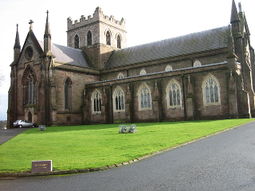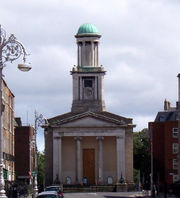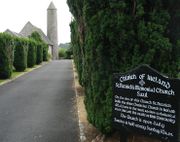Church of Ireland
|
Modern logo of the Church of Ireland |
|
| Primate | Alan Harper |
|---|---|
| Headquarters | See House, Cathedral Close, Armagh, BT61 7EE, Northern Ireland |
| Territory | Ireland |
| Members | 365,000[1] |
| Website | www.ireland.anglican.org |
| Anglicanism Portal | |

The Church of Ireland (Irish: Eaglais na hÉireann)[2] is a Protestant church, an autonomous province of the Anglican Communion, operating across the island of Ireland, and the largest non-Roman Catholic religious body on the island. Like other Episcopal churches, it considers itself to be both Catholic, in that its beliefs and practices are based on a continuous tradition dating back to the early Church, and Reformed, in that it does not accept the universal jurisdiction of the Pope.[3]
Contents |
Overview
When the church in England broke communion from the Roman Catholic Church, all but two of the bishops of the Church in Ireland followed the Church of England, although almost no clergy or laity did so. The new body became the State Church, assuming possession of most Church property (and so retaining a great repository of religious architecture and other items, though some were later destroyed). The substantial majority of the population remained strongly Roman Catholic, despite the political and economic advantages of membership in the state church. Despite its numerical minority, however, the Church of Ireland remained the official state church until it was disestablished on 1 January 1871 by the Liberal government under William Ewart Gladstone.
Today the Church of Ireland is, after the Roman Catholic Church, the second-largest denomination in the island of Ireland and the largest Protestant tradition (the second-largest in Northern Ireland after Presbyterianism).
Ecclesiastical governance
The diocesan system of Christian church government in Ireland was set up by the Synod of Rathbreasail in 1111 and modified by the Synod of Kells in 1152. The island of Ireland was divided into four ecclesiastical provinces each headed by a metropolitan archbishop. While the Roman Catholic Church in Ireland retains four provinces, the Church of Ireland has only two provinces: Armagh and Dublin. This significant structural departure was necessitated in view of declining membership. Over the centuries numerous dioceses were merged. The two remaining provinces, constituted into twelve dioceses, are governed in common by a General Synod of clergy and laity led by the Archbishop of Armagh (styled "Primate of All Ireland"), currently the Most Reverend Dr Alan Harper; the church's other archbishop is the Archbishop of Dublin, the Most Reverend Dr. John Neill (styled "Primate of Ireland").
History
Reformation
In 1536 during the Reformation, Henry VIII arranged to be declared head of the Church in Ireland through an Act of the Irish Parliament. When the Church of England was re-formed under Edward VI, so too was the Church of Ireland. All but two of the Irish bishops accepted the Elizabethan Settlement, although the vast majority of priests and the church membership remained Roman Catholic. The Church of Ireland claims Apostolic succession because of the continuity in the hierarchy; however, this is disputed by the Roman Catholic Church which asserts that only those bishops approved by and in communion with the Holy See are legitimate.
The church established by decree of the Irish Parliament (a.k.a. the "established church") underwent a period of more radical Calvinist doctrine than occurred in England. James Ussher (later Archbishop of Armagh) authored the Irish Articles, adopted in 1615. In 1634, the Irish Convocation adopted the English Thirty-Nine Articles alongside the Irish Articles. After the Restoration of 1660, it seems that the Thirty-Nine Articles took precedence; they remain the official doctrine of the Church of Ireland even after disestablishment.[4]
The Church of Ireland undertook the first publication of Scripture in the Irish language. The first Irish translation of the New Testament was begun by Nicholas Walsh, Bishop of Ossory, who worked on it until his death in 1585. The work was continued by John Kearny, his assistant, and Dr. Nehemiah Donellan, Archbishop of Tuam; it was finally completed by William O'Domhnuill (William Daniell, Archbishop of Tuam in succession to Donellan). Their work was printed in 1602. The work of translating the Old Testament was undertaken by William Bedel (1571-1642), Bishop of Kilmore, who completed his translation within the reign of Charles I, although it was not published until 1680 in a revised version by Narcissus Marsh (1638-1713), Archbishop of Dublin. William Bedell had undertaken a translation of the Book of Common Prayer in 1606. An Irish translation of the revised prayer book of 1662 was effected by John Richardson (1664-1747) and published in 1712.
The English-speaking minority mostly adhered to the Church of Ireland or to Presbyterianism, while the Irish-speaking majority remained faithful to the Latin liturgy of Roman Catholicism, which remained by far the majority denomination in Ireland.
Union with Great Britain

When Ireland was incorporated in 1801 into the new United Kingdom of Great Britain and Ireland, the Church of Ireland was also united with the Church of England to form the United Church of England and Ireland. At the same time, one archbishop and three bishops from Ireland (selected by rotation) were given seats in the House of Lords at Westminster, joining the two archbishops and twenty-four bishops from the Church of England.
In 1833, the British Government proposed the Irish Church Measure to reduce the 22 archbishops and bishops who oversaw the Anglican minority in Ireland to a total of 12 by amalgamating sees and using the revenues saved for the use of parishes. This sparked the Oxford Movement, which was to have wide repercussions for the Anglican Communion.
As the official established church, the Church of Ireland was funded partially by tithes imposed on all Irish subjects of the Crown. Irrespective of the fact that the adherents of the church were never more than a small minority of the populace, the population at large was expected to pay for its upkeep. Following the defeat of Catholic arms in 1691, no armed resistance was to be expected to this discriminatory policy. Nevertheless, peasant resentment of the tithes occasionally boiled over, as in the "Tithe War" of 1831/36. Eventually, the tithes were ended, replaced with a lower levy called the tithe rentcharge. The last remnant of the tithes was not abolished until disestablishment in 1871.
The Irish Church Act 1869 (which took effect in 1871) finally ended the role of the Church of Ireland as state church. This terminated both state support and parliament's role in its governance, but also took into government ownership much church property. At the establishment of the state Church, no compensation was given to Catholic clergy by the state who suffered loss by the seizure of Church property; at its disestablishment, compensation was provided to clergy by the state. On both occasions, parishes faced great difficulty in local financing after the loss of rent-generating lands and buildings. The Church of Ireland made provision in 1870 for its own government, led by a General Synod, and with financial management by a Representative Church Body. With disestablishment, the Church's representation in the House of Lords also ceased.
Like other Irish churches, the Church of Ireland did not divide when Ireland was partitioned in the 1920s. It continues to be governed on an all-Ireland basis.
The Church today

The contemporary Church of Ireland, despite having a number of High Church (often described as Anglo-Catholic) parishes, is generally on the Low Church end of the spectrum of world Anglicanism. Historically, it had little of the difference in churchmanship between parishes characteristic of other Anglican Provinces, although a number of markedly liberal, High Church or evangelical parishes have developed in recent decades. It was the second province of the Anglican Communion after the Anglican Church of New Zealand (1857) to adopt, on its 1871 disestablishment, synodical government, and was one of the first provinces to ordain women to the priesthood (1991).
The Church of Ireland has two cathedrals in Dublin: within the walls of the old city is Christ Church Cathedral, the seat of the Archbishop of Dublin, and just outside the old walls is St. Patrick's Cathedral, which the Church designated as a National Cathedral for Ireland in 1870. Cathedrals also exist in the other dioceses. The Church operates a seminary, the Church of Ireland Theological College, in Rathgar, in the south inner suburbs of Dublin. The Church's central offices are in Rathmines, adjacent to the Church of Ireland College of Education, and the Church's library is in Rathgar.

In 1999, The Church voted to prohibit the flying of flags other than the St Patricks Flag.[5] However, the Union Flag continues to fly on many churches in Northern Ireland.
Membership
The Church of Ireland experienced major decline during the 20th century, both in Northern Ireland, where around 65% of its members live, and in the Republic of Ireland which contains upwards of 35%. However, the Church of Ireland in the Republic has shown substantial growth in the last two national censuses; its membership is now back to the levels of sixty years ago (albeit with fewer churches as many have been closed). Church membership increased by 8.7% in the period 2002–2006, during which the population as a whole increased by only 8.2%.[6] Various reasons for this increase have been proposed. One is the relaxation of the Ne Temere regulations that stipulated that children of mixed Roman Catholic-Protestant marriages should be brought up as Roman Catholics. It is also partly explained by the number of Anglican immigrants who have moved to Ireland recently.
The 2006 Census in the Republic of Ireland showed that the numbers of people describing themselves as members of the Church of Ireland increased in every county. The highest percentage growth was in the west (Counties Galway, Mayo, and Roscommon) and the largest numerical growth was in the mid-east region (Counties Wicklow, Kildare, and Meath). Co Wicklow is the county with the highest proportion of Church of Ireland members (6.88%); Greystones Co. Wicklow has the highest proportion of any town (9.77%).
Structure
The polity of the Church of Ireland is Episcopal church governance, which is the same as other Anglican churches. The Church maintains the traditional structure dating to pre-Reformation times, a system of geographical parishes organized into dioceses. There are twelve of these, each headed by a bishop. The leader of the five southern bishops is the Archbishop of Dublin; that of the seven northern bishops is the Archbishop of Armagh; these are styled Primate of Ireland and Primate of All Ireland, respectively, suggesting the ultimate seniority of the latter. Although he has relatively little absolute authority, the Archbishop of Armagh is respected as the Church's general leader and spokesman, and is elected in a process different from those for all other bishops.
Canon law and church policy are decided by the Church's General Synod, and changes in policy must be passed by both the House of Bishops and the House of Representatives (Clergy and Laity). Important changes, e.g., the decision to ordain female priests, must be passed by two-thirds majorities. While the House of Representatives always votes publicly, often by orders, the House of Bishops has tended to vote in private, coming to a decision before matters reach the floor of the Synod. This practice has been broken only once, when in 1999 the House of Bishops voted unanimously in public to endorse the efforts of the Archbishop of Armagh, the Diocese of Armagh, and the Standing Committee of the General Synod of the Church of Ireland in their attempts to resolve the crisis at the Church of the Ascension at Drumcree, near Portadown.
The Church of Ireland embraces three orders of ministry: deacon, priest (or presbyter), and bishop. These orders are distinct from functional titles such as rector, vicar or canon.
Worship and liturgy
Book of Common Prayer
The first translation of the Book of Common Prayer was published in 1606. An Irish translation of the revised prayer book of 1662 was published in 1712.
Doctrine and practice
The centre of the Church of Ireland's teaching is the life, death, and resurrection of Jesus Christ. The basic teachings of the Church include:
- Jesus Christ is fully human and fully God in one person. He died and was resurrected from the dead.
- Jesus provides the way of eternal life for those who believe.
- The Old and New Testaments of the Bible ("God's Word written") were written by people "under the inspiration of the Holy Spirit." The Apocrypha are additional books that are to be read, but not to determine doctrine.
- The two great and necessary sacraments are Holy Baptism and The Lord's Supper/ Holy Communion/ the Eucharist.
- Those "commonly called Sacraments that are not to be counted for Sacraments of the Gospel" are confirmation, ordination, marriage, reconciliation of a penitent, and unction.
- Belief in heaven, hell, and Jesus's return in glory.
The threefold sources of authority in Anglicanism are scripture, tradition, and reason. These three sources uphold and critique each other in a dynamic way. This balance of scripture, tradition, and reason is traced to the work of Richard Hooker, a sixteenth-century apologist. In Hooker's model, scripture is the primary means of arriving at doctrine; things stated plainly in scripture are accepted as true. Issues that are ambiguous are determined by tradition, which is checked by reason.[7]
Ecumenical relations
Like many other Anglican churches, the Church of Ireland is a member of many ecumenical bodies, including the World Council of Churches, the Conference of European Churches, Churches Together in Britain and Ireland, and the Irish Council of Churches. It is also a member of the Porvoo Communion.
Irish language
The Church of Ireland has its own Irish language body, Cumann Gaelach na hEaglaise (the Irish Guild of the Church). This was founded in 1914 to bring together members of the Church of Ireland interested in the Irish language and Gaelic culture, and to promote the Irish language within the Church of Ireland. The Cumann aims to link its programmes with the Irish language initiatives which have been centred round Christ Church Cathedral. It holds services twice a month in Irish.[8]
From 1926 to 1995, the Church had its own Irish-language teacher training college, Coláiste Moibhí.
See also
- List of Church of Ireland dioceses
- List of Roman Catholic dioceses in Ireland
- Christianity in Ireland
- Religion in the United Kingdom
- Irish Anglicans
- Fellowship Of Vocation
- Bishops' Selection Conference
- Anglo-Irish
References
- ↑ World Council of Churches
- ↑ Placenames Database of Ireland - Civil parishes: in Irish and English - "na bparóistí Caitliceacha nua-aimseartha ná pharóistí Eaglais na hÉireann."
- ↑ Protestant and Catholic, APCK Study Leaflet, 1996
- ↑ Creeds of Christendom, with a History and Critical notes. Volume I. The History of Creeds. | Christian Classics Ethereal Library
- ↑ Flags of the World: St. Patrick's Flag as flag of Church of Ireland: "The General Synod of the Church of Ireland recognises that from time to time confusion and controversy have attended the flying of flags on church buildings or within the grounds of church buildings. This Synod therefore resolves that the only flags specifically authorised to be flown on church buildings or within the church grounds of the Church of Ireland are the cross of St Patrick or, alternatively, the flag of the Anglican Communion bearing the emblem of the Compassrose. Such flags are authorised to be flown only on Holy Days and during the Octaves of Christmas, Easter, the Ascension of Our Lord, Pentecost, and on any other such day as may be recognised locally as the Dedication Day of the particular church building. Any other flag flown at any other time is not specifically authorised by this Church...."
- ↑ Republic of Ireland Central Statistics Office, Census 2006: Principal Demographic Results.
- ↑ Anglican Listening Detail on how scripture, tradition, and reason work to "uphold and critique each other in a dynamic way".
- ↑ Church of Ireland Notes, page 2, Irish Times, 10 January 2009
Further reading
- Cross, F. L. (ed.) (1957) The Oxford Dictionary of the Christian Church. Oxford: U. P.; pp. 700-701
- Neill, Stephen (1965) Anglicanism. Harmondsworth: Penguin Books
- MacCarthy, Robert Ancient and Modern: a short history of the Church of Ireland. Four Courts Press Ltd., 1995
External links
|
|||||||
|
|||||||||||